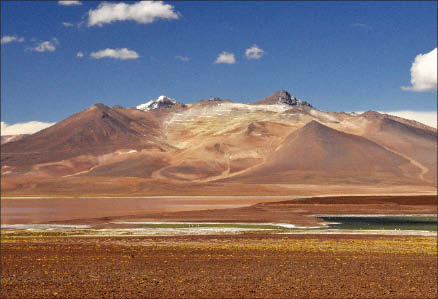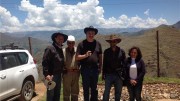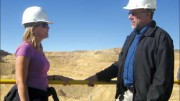Andina Minerals (ADM-V) hopes to supercharge its promising Volcan gold project as it explores a number of high-grade targets around its initial Dorado deposit, situated 120 km east of this mining centre in Chile’s Atacama Desert.
The Volcan deposit lies beneath the slope of 6,000-metre-high Copiapo Volcano in the middle of the Maricunga gold belt, which promises to make Chile a leading producer of the precious metal later this decade.
Since going public in 2004 via a reverse takeover with junior Castlerock Resources, Andina’s drilling has confirmed some 6.6 million oz. gold contained in 282.6 million proven and probable tonnes grading 0.726 gram gold per tonne.
Andina’s shares hit highs above $5 in late 2007 before collapsing to a tenth of that level in the wake of the global economic collapse. They have since stabilized at around $1.50.
In early 2009, the company brought in new managers with considerable experience in developing and operating mines, giving them a mandate to turn Volcan from a promising deposit into a feasible mining project.
During two decades working for Barrick Gold (ABX-T, ABX-N), current Andina president and CEO George Bee operated the major’s Pierina gold mine in Peru before developing its Veladero gold mine just over the Andes in neighbouring Argentina, and was involved in Aurelian Resources’ Fruta del Norte gold project in Ecuador before the company was snapped up by Kinross Gold (K-T, KGC-N) in 2008.
Like Veladero, Bee says Volcan is a large-tonnage, low-grade heap leach operation, but with an added bonus of Chile offering a much more stable regulatory framework than other places he has worked.
The project is run on the ground by Alejandro Labbe, a former Hatch engineer, who operated some of the world’s largest copper mines at Chile’s state-owned Codelco before joining Barrick.
In a prefeasibility study released last February, the Andina team set out a plan to develop around three-quarters of the resources found at the property’s key Dorado deposit.
The study suggests a 55,000- tonne-per-day operation with around 80% of the material going through a conventional heap-leach pad, and the remainder, consisting of high-grade material and fines, to be milled.
This approach should not only improve gold recovery rates from the higher-grade ore, but also prevent fine material from clogging up the heap-leach process.
Material will be transported from the mine to the plant via conveyor belt, and waste material will stored in a nearby ravine. Power can be brought in reasonably easily, and the company already holds water rights from a nearby well that exceeds the project’s needs and does not impose on local communities – a key issue in this arid region.
Gold production would average 287,000 oz. a year during its first five years with cash costs estimated at US$586 per oz. gold.
The design is a reasonably simple one requiring just two years for construction. If the project advances as planned,
production could begin as soon as 2015.
Andina has now begun a feasibility study for Volcan, and aims to complete it during the first half of 2012.
However, Bee says that the prefeasibility study is just a snapshot of the team’s changing approach to the project, and the mine plan could undergo several modifications over the next 12 months.
According to Bee, the aim is to “enhance and optimize the project, and make it an extremely compelling project at a gold price of US$1,025, let alone the current price of US$1,500-plus per oz.”
As well as mining and civil engineering studies, work has begun on a US$1-million metallurgical program which should suss out possible enhancements to the process plant.
In particular, Andina is considering adding a sulphidization, acidification, recycling and thickening – or SART – process to the flowsheet to reduce the copper content in pregnant leach solution from the pad.
This SART technology, which has been applied at several gold mines around the world, will not only allow Andina to recover a marketable copper sulphate precipitate but also reduce consumption of cyanide, and hence cut production costs.
By spending an extra US$26 million for the SART technology, the company expects net savings of more than US$11 million, or a much higher figure if the drop in cyanide consumption exceeds the company’s modest 10% forecast.
Another option under study is the inclusion of a flotation process ahead of the carbon-in-leach plant to produce a copper concentrate and gold in pyrite, as well as reducing copper content.
Andina is also considering adding higher-grade material from new targets on the company’s 250-sq.-km property in the Maricunga area, which would allow the company to run the planned mill solely on high-grade ore.
Andina believes that they have already found one “modest but important” source in the Ojo de Agua East deposit situated 6.5 km northeast of the Dorado zone and just 4 km north of the proposed mill and heap-leach pad.
Results from the property, acquired from Barrick two years ago, have been promising, with one hole drilled earlier this year hitting almost 4 grams gold over 30 metres.
In late May 2011, Andina unveiled results of a second set of 20 drill holes completed this year at Ojo de Agua East, part of a 10,000-metre exploration drilling program completed before the start of Chile’s winter.
One hole returned 1.0 gram gold per tonne over 266 metres (from 56 metres down-hole), including 2.6 grams gold over 54 metres.
Andina is now hurrying to process material from the final six holes, and expects to have assays in hand by June.
The company also expects to unveil an initial resource estimate for Ojo de Agua East sometime during the third quarter, which would allow the deposit to be incorporated into the Volcan project.
“This higher-grade material could perhaps double the average grade of the current average grade of the Volcan project,” Bee says. “It will be a great sweetener during the early years of the project, and we can expect improved project economics as we incorporate this material.”
The company is now looking at drilling another 20,000 metres during the 2011-2012 season to consolidate its success at Ojo de Agua East, perhaps targeting the adjacent Florencia and Andrea deposits, Bee adds.
More resources could lead Andina to consider a larger project that would mine the deposit faster and bring forward future revenue streams. But that will have to be balanced by the requirements for start-up capital, which currently stands at US$575 million.
“A bigger project looks better, but we would need access to a bigger balance sheet to finance it,” Bee admits.
Another option could be greater cooperation with other like-minded producers, as the Maricunga belt is bristling with new gold projects at different stages of development.
For instance, just north of Volcan, Yamana Gold (YRI-T, AUY-N) has been exploring La Pepa deposit and Kinross has begun work on its Lobo Marte deposit. On the other side of Negro Francisco Lagoon sits Kinross’s Maricunga mine, and beyond that, Exeter Resource‘s (XRC-T, XRA-X) Caspiche project and Barrick’s giant Cerro Casale advanced gold-copper project.
Andina estimates the region could contain as much as 60 million oz. of gold to be dug up.
With access to significant water rights and a strategic location in the middle of the Maricunga belt, Andina expects to play a key role in the development of this frontier for gold mining.
Chilean authorities forecast that the country’s gold production is set to triple over the next five years to around 120 tonnes (3.86 million oz.) a year, largely thanks to Barrick’s two megaprojects in the region.
Andina hopes it will help the country to produce much more than that in the coming years.
– Based
in Santiago, the author is a freelance journalist specializing in mining. He can be reached at tomazzopardi@vtr.net.






Be the first to comment on "Andina Minerals goes after the good stuff in Maricunga (June 06, 2011)"